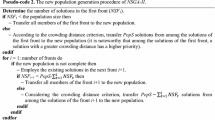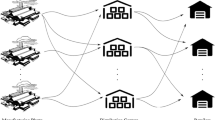Abstract
In this paper, the joint replenishment-location problem of some distribution centers (DCs) with a centralized decision maker who is responsible for ordering and dispatching shipments of a single product is modeled. The warehouse spaces of the DCs are limited and the product is sold under an incremental discount policy. The model seeks to minimize the total cost of the supply chain under the joint replenishment policy along with minimizing the cost of locating the DCs in potential sites as the first objective. The second objective is to minimize the warehouse space of all DCs using the revisable approach. As the proposed model is a bi-objective integer non-linear optimization problem (NP-Hard) and cannot be solved by an exact method in a reasonable computational time, a multi-objective harmony search algorithm is developed to solve it. Since there is no benchmark available in the literature, the non-dominated sorting genetic algorithm II is utilized as well to validate the results obtained. As the performance of a meta-heuristic algorithm is largely influenced by the choice of its parameters, the response surface methodology is employed to tune the parameters. Several numerical illustrations are provided at the end to not only demonstrate the application of the proposed methodology, but also to analyze and compare the performances of the two solution algorithms in terms of several multi-objective measures.
















Similar content being viewed by others
References
Alikar N, Mousavi SM, Ghazilla RA, Tavana M, Olugu EU (2017) Application of the NSGA-II algorithm to a multi-period inventory-redundancy allocation problem in a series-parallel system. Reliab Eng Syst Saf 160:1–10
Archetti C, Bertazzi L, Laporte G, Speranza MG (2007) A branch-and-cut algorithm for a vendor-managed inventory-routing problem. Transp Sci 41:382–391
Arkin E, Joneja D, Roundy R (1989) Computational complexity of uncapacitated multi-echelon production planning problems. Oper Res Lett 8:61–66
Bouajaja S, Dridi N (2017) A survey on human resource allocation problem and its applications. Oper Res Int J 17:339–369
Buyukkaramikli NC, Gurler U, Alp O (2014) Coordinated logistics: joint replenishment with capacitated transportation for a supply chain. Prod Oper Manag 23:110–126
Cha BC, Moon IK (2005) The joint replenishment problem with quantity discounts under constant demand. Oper Res Spectr 27:569–581
Cha BC, Moon IK, Park JH (2008) The joint replenishment and delivery scheduling of the one-warehouse, n-retailer system. Transp Res Part E 44:720–730
Chan CK, Cheung BK, Langevin A (2003) Solving the multi-buyer joint replenishment problem with a modified genetic algorithm. Transp Res Part B Methodol 37:291–299
Chen SJ, Hwang CL (1992) Fuzzy multiple attribute decision making: methods and applications. Springer, Berlin
Coelho LC, Laporte G (2014) Optimal joint replenishment, delivery and inventory management policies for perishable products. Comput Oper Res 47:42–52
Cui LG, Wang L, Deng J (2014) RFID technology investment evaluation model for the stochastic joint replenishment and delivery problem. Expert Syst Appl 41:1792–1805
Deb K, Agrawal S, Pratap A, Meyarivan T (2000) A fast elitist non-dominated sorting genetic algorithm for multi-objective optimization: NSGA-II. In: Schoenauer M et al. (eds) Parallel Problem Solving from Nature PPSN VI PPSN 2000. Lecture notes in Computer Science, vol 1917. Springer, Berlin, pp 849–858
Deb K, Pratap A, Agrawal S, Meyarivan T (2002) A fast and elitist multiobjective genetic algorithm: NSGA-II. IEEE Trans Evol Comput 6:182–197
Fung R, Ma X (2001) A new method for joint replenishment problems. J Oper Res Soc 52:358–362
Geem ZW, Kim JH, Loganathan GV (2001) A new heuristic optimization algorithm: harmony search. Simulations 76:60–68
Goyal SK, Deshmukh SG (1993) The economic ordering quantity for jointly replenishment items. Int J Prod Res 31:109–116
Hajipour V, Rahmati SHA, Pasandideh SHR, Niaki STA (2014) A multi-objective harmony search algorithm to optimize multi-server location-allocation problem in congested systems. Comput Ind Eng 72:187–197
Hariga M (1994) Two new heuristic procedures for the joint replenishment problem. J Oper Res Soc 45:463–471
Hong SP, Kim YH (2009) A genetic algorithm for joint replenishment based on the exact inventory cost. Comput Oper Res 36:167–175
Hoque MA (2006) An optimal solution technique for the joint replenishment problem with storage and transport capacities and budget constraints. Eur J Oper Res 175:1033–1042
Hsu SL (2009) Optimal joint replenishment decisions for a central factory with multiple satellite factories. Expert Syst Appl 36:2494–2502
Hwang CL, Yoon K (1981) Multiple attribute decision making methods and applications. Springer, Berlin
Kaspi M, Rosenblatt MJ (1991) On the economic ordering quantity for jointly replenishment items. Int J Prod Res 29:107–114
Khouja M, Michalewicz Z, Satoskar S (2000) A comparison between genetic algorithms and the RAND method for solving the joint replenishment problem. Prod Plan Control Manag Oper 11:556–564
Lee KS, Geem ZW (2004) A new structural optimization method based on the harmony search algorithm. Comput Struct 82:781–798
Lee FC, Yao MJ (2003) A global optimum search algorithm for the joint replenishment problem under power-of-two policy. Comput Oper Res 30:1319–1333
Li Q (2004) Solving the multi-buyer joint replenishment problem with the RAND method. Comput Ind Eng 46:755–762
Lu T, Jia S, Li Y (2010) A modified RAND algorithm for multi-buyer joint replenishment problem with resource constraints. In: Information science and engineering, conference location: Hangzhou. China, pp 2526–2529. https://doi.org/10.1109/icise.20
Mousavi SM, Sadeghi J, Niaki STA, Tavana M (2016) A bi-objective inventory optimization model under inflation and discount using tuned Pareto-based algorithms: NSGA-II, NRGA, and MOPSO. Appl Soft Comput 43:57–72
Olsen AL (2005) An evolutionary algorithm to solve the joint replenishment problem using direct grouping. Comput Ind Eng 48:223–235
Olsen AL (2008) Inventory replenishment with interdependent ordering: An evolutionary algorithm solution. Int J Prod Econ 113:359–369
Pasandideh SHR, Niaki STA, Maleki L (2014) A queuing approach for a tri-objective manufacturing problem with defects: a tuned Pareto-based genetic algorithm. Int J Adv Manuf Technol 73:1373–1385
Paul S, Wahab MIM, Ongkunaruk P (2014) Joint replenishment with imperfect items and price discount. Comput Ind Eng 74:179–185
Porras E, Dekker R (2006) An efficient optimal solution method for the joint replenishment problem with minimum order quantities. Eur J Oper Res 174:1595–1615
Qu H, Wang L, Liu R (2015) A contrastive study of the stochastic location-inventory problem with joint replenishment and independent replenishment. Expert Syst Appl 42:2061–2072
Ranjbar F, Mohammadi M, Pasandideh SHR (2017) Bi-objective location-allocation-inventory-network design in a two-echelon supply chain using de- novo programming, NSGA-II & NRGA. International Journal of Logistics Systems and Management 28:308–337
Sadeghi J, Sadeghi S, Niaki STA (2014) A hybrid vendor managed inventory and redundancy allocation optimization problem in supply chain management: an NSGA-II with tuned parameters. Comput Oper Res 41:53–64
Silva F, Gao L (2013) A joint Replenishment Inventory-location model. Netw Spat Econ 13:107–122
Sindhuchao S, Romeijn HE, Akcali E, Boondiskulchok R (2005) An inventory-routing system for multi-item joint replenishment with limited vehicle capacity. J Global Optim 32:93–118
Sivasubramani S, Swarup KS (2011) Multi-objective harmony search algorithm for optimal power flow problem. Int J Electr Power Energy Syst 33:745–752
Solyali O, Sural H, Denizel M (2010) The one-warehouse multi-retailer problem with an order up to level inventory policy. Naval Res Logist 57:653–666
van Eijs MJG (1993) A note on the joint replenishment problem under constant demand. J Oper Res Soc 44:185–191
Viswanathan S (1996) A new optimal algorithm for the joint replenishment problem. J Oper Res Soc 47:936–944
Wang YC, Cheng WT (2008) A sensitivity analysis of solving joint replenishment problems using the RAND method under inaccurate holding cost estimates and demand forecasts. Comput Ind Eng 55:243–252
Wang L, Dun CX, Bi WJ, Zeng YR (2012) An effective and efficient differential evolution algorithm for the integrated stochastic joint replenishment and delivery model. Knowl Based Syst 36:104–114
Wang L, Qu H, Chen T, Yan FP (2013) An effective hybrid self-adapting differential evolution algorithm for the joint replenishment and location-inventory problem in a three-level supply chain. Sci World J 270249:1–11. https://doi.org/10.1155/2013/270249
Wang L, Qu H, Liu S, Chen C (2014) Optimizing the joint replenishment and channel coordination problem under supply chain environment using a simple and effective differential evolution algorithm. Discrete Dyn Nat Soc 709856:1–12. https://doi.org/10.1155/2014/709856
Wang L, Shi Y, Liu S (2015) An improved fruit fly optimization algorithm and its application to joint replenishment problems. Expert Syst Appl 42:4310–4323
Zachariadis EE, Tarantilis CD, Kiranoudis CT (2015) Vehicle routing strategies for pick-up and delivery service under two dimensional loading constraints. Oper Res Int J 17:115–143
Zeleny M (1982) Multiple criteria decision making. McGraw Hill Book Company, New York
Zitzler E, Thiele L (1998) Multi-objective optimization using evolutionary algorithms, a comparative case study. In: Eiben AE, Back T, Schoenauer M, Schwefel HP (eds) Fifth international conference on parallel problem solving from nature (PPSN-V), Berlin, Germany, 1998, pp 292–301
Author information
Authors and Affiliations
Corresponding author
Rights and permissions
About this article
Cite this article
Pasandideh, S.H.R., Niaki, S.T.A. & Abdollahi, R. Modeling and solving a bi-objective joint replenishment-location problem under incremental discount: MOHSA and NSGA-II. Oper Res Int J 20, 2365–2396 (2020). https://doi.org/10.1007/s12351-018-0423-0
Received:
Revised:
Accepted:
Published:
Issue Date:
DOI: https://doi.org/10.1007/s12351-018-0423-0




